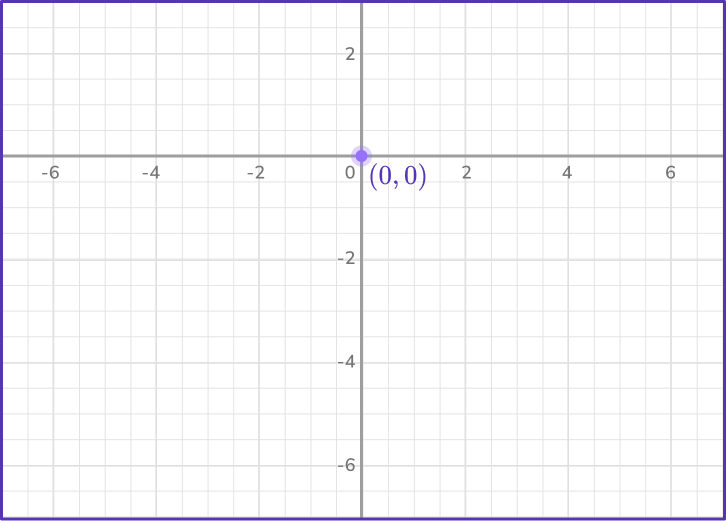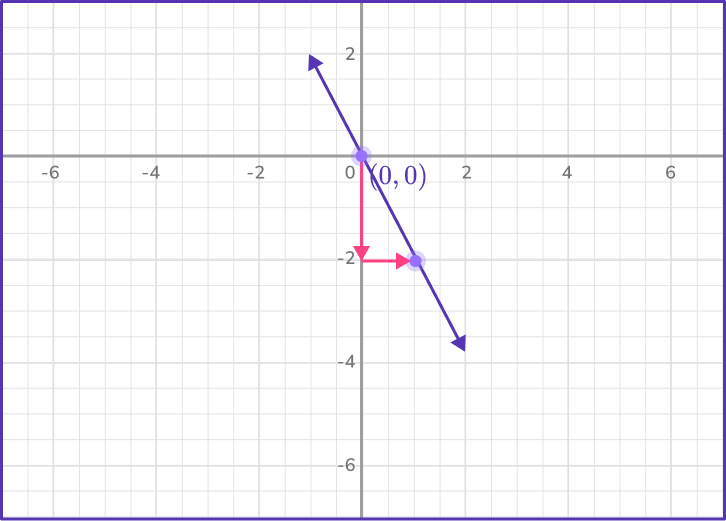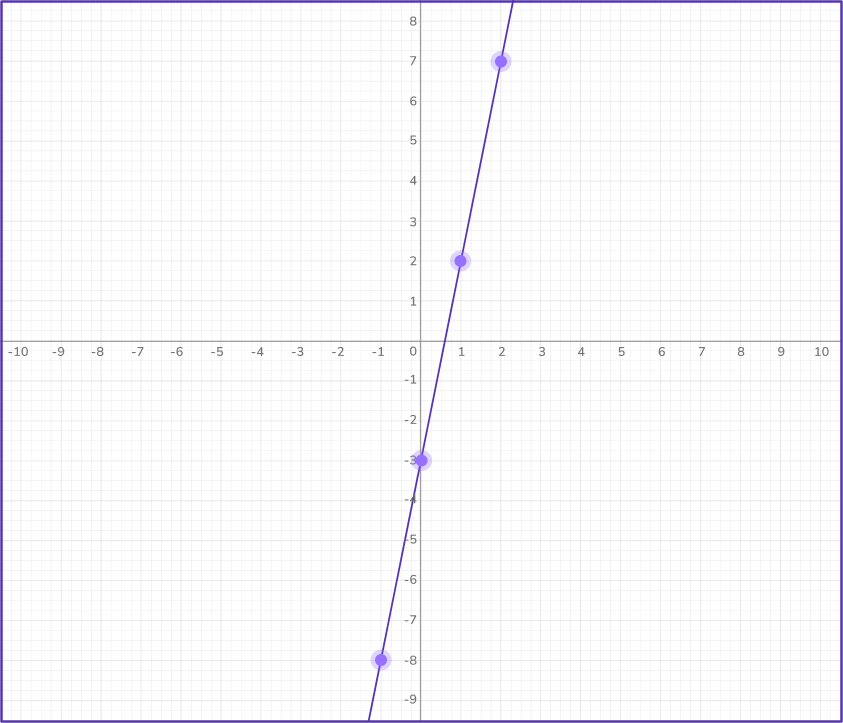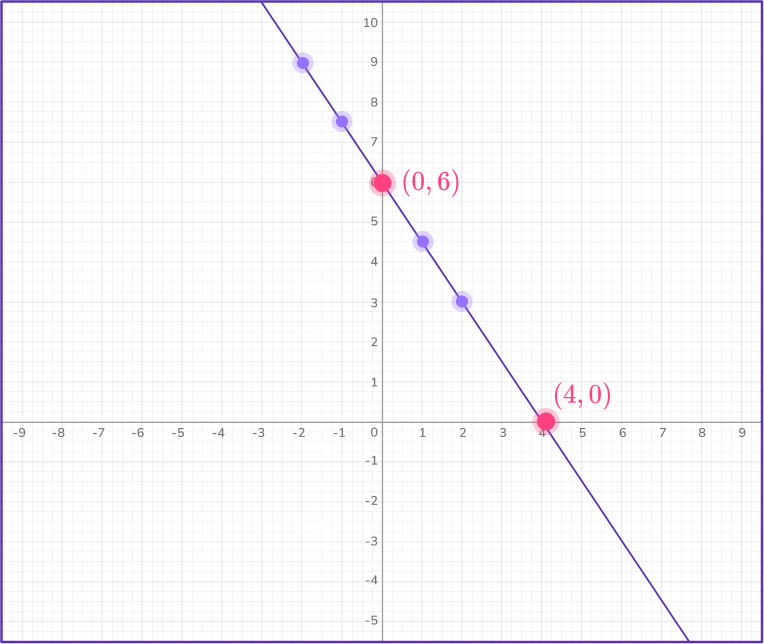High Impact Tutoring Built By Math Experts
Personalized standards-aligned one-on-one math tutoring for schools and districts
In order to access this I need to be confident with:
Independent and dependent variables
Interpreting graphs Linear graphGraphing linear equations
Here you will learn about straight line graphs including how to draw straight lines graphs in the form y=mx+b, using a table and from a pair of coordinates, and how to use the x and y intercepts to graph a line.
You will learn how to calculate the slope of a straight line including parallel and perpendicular lines, and how to quickly sketch a straight line graph with limited information.
Students first learn about linear equations in middle school when they work with the constant of proportionality. They build upon that knowledge as they progress through high school algebra.
What is graphing linear equations?
The graph of a linear equation is a visual representation of a linear function. There are several ways you can express linear equations and graph linear equations. Let’s focus on the slope intercept form of a linear equation which is defined as:
y=mx+bWhere the slope (slant) of the line is represented by the variable, m and the y -intercept (point where the line crosses the y -axis) is represented by the variable, b.
Looking at the equation, y=-x+2 , you can define the slope of the line, m, to be the coefficient of the x term and the y -intercept, b, to be the constant.
In this case, m=-1 and b=2.
Let’s investigate strategies on how to use the equation of line to graph it on the coordinate plane.
Graphing a line using a table
Let’s use the equation below to graph the line using a table.
y=-x+2When using a table, you can select whatever values you would like for the x -coordinate because it is the independent variable to substitute into the equation and solve for y.
When selecting values for x, select numbers that are easy to calculate.

Once you complete the table, take each of the ordered pairs and plot them on the coordinate plane. If the points do not line up, then there could be a calculation error. So, be sure to go back and check your work.

Notice, the y -intercept is (0, 2) because it is the point where the line crosses the y -axis. Also, notice the point (2, 0). It is the x -intercept because it is the point where the line crosses the x -axis.
You can also see that from point to point there is a movement of 1 unit down and 1 unit right, which defines the slope of -1.
Step-by-step guide: How to find the slope of a line
![[FREE] Algebra Check for Understanding Quiz (Grade 6 to 8)](https://thirdspacelearning.com/wp-content/uploads/2023/07/Algebra-check-for-understanding-quiz-listing-image-.png)
[FREE] Algebra Check for Understanding Quiz (Grade 6 to 8)
![[FREE] Algebra Check for Understanding Quiz (Grade 6 to 8)](https://thirdspacelearning.com/wp-content/uploads/2023/07/Algebra-check-for-understanding-quiz-listing-image-.png)
Use this quiz to check your grade 6 to 8 students’ understanding of algebra. 10+ questions with answers covering a range of 6th and 8th grade algebra topics to identify areas of strength and support!
DOWNLOAD FREE![[FREE] Algebra Check for Understanding Quiz (Grade 6 to 8)](https://thirdspacelearning.com/wp-content/uploads/2023/07/Algebra-check-for-understanding-quiz-listing-image-.png)
[FREE] Algebra Check for Understanding Quiz (Grade 6 to 8)
![[FREE] Algebra Check for Understanding Quiz (Grade 6 to 8)](https://thirdspacelearning.com/wp-content/uploads/2023/07/Algebra-check-for-understanding-quiz-listing-image-.png)
Use this quiz to check your grade 6 to 8 students’ understanding of algebra. 10+ questions with answers covering a range of 6th and 8th grade algebra topics to identify areas of strength and support!
DOWNLOAD FREEGraphing a line using the equation in slope intercept form
Now, let’s use the same linear equation to graph the line using the slope and the y -intercept.
y=-x+2First, identify the slope which in this case is -1. You know that the slope is -1 because it is the coefficient of the x term and it is the number in place of m.
The slope is defined as two movements the vertical movement over the horizontal movement or \cfrac{\text { rise }}{\text { run }}, \, so in this case, \cfrac{-1}{1} which indicates 1 unit down and 1 unit right.
Next, identify the y -intercept. In this case, the y -intercept is 2. You know that the y -intercept is 2 because it is the constant and the number in place of b.
Now let’s plot the line on the graph. Start by plotting the y -intercept. Since we know the y -intercept is 2 the actual ordered pair is (0, 2). Starting at that point, down 1 unit and to the right 1 unit.

Step-by-step guide: y = mx + b
Graphing a line using the x- intercept and the y- intercept
Using the same linear equation, y=-x+2, let’s find the x -intercept and the y -intercept to graph the line on the coordinate plane.
Recall, the x -intercept is the point where the line intersects the x -axis and the y -intercept is the point where the line intersects the y -axis.
To find the x -intercept, substitute 0 into the equation for y and then solve for x. You can use this strategy because the ordered pair for a point on the x -axis has a 0 for the y -coordinate.
\begin{aligned} & y=-x+2 \\\\ & 0=-x+2 \\\\ & 0-2=-x+2-2 \\\\ & -2=-x \\\\ & \cfrac{-2}{-1}=\cfrac{-x}{-1} \\\\ & 2=x \text { or } x=2 \end{aligned}Since x = 2 , the x -intercept is 2 and it has an ordered pair of (2, 0).
To find the y -intercept, substitute the 0 into the equation for x and then solve for y. You can use this strategy because the ordered pair for a point on the y -axis has a 0 for the x -coordinate.
\begin{aligned} & y=-x+2 \\\\ & y=-(0)+2 \\\\ & y=2 \end{aligned}Since y = 2, the y -intercept is 2 and it has an ordered pair of (0, 2).
Plot the x -intercept and the y -intercept on the coordinate plane and connect the two points with a straight line. You can still see the slope to be 1 unit down and 1 unit right.

Step-by-step guide: How to find the y intercept
Let’s look at how to find the midpoint of a line segment and the distance between points on the coordinate plane.
The midpoint of a line segment is a point that lies exactly halfway between two points. It is the same distance from each endpoint of the straight line segment.
The endpoints of the line segment on the coordinate plane are (-2, 2) and (4, 6).
The formula you can use to find the midpoint is average of the x coordinates x\, (\text{midpoint})=\cfrac{x 1+x 2}{2} and the average of the y coordinates, y \, (\text{midpoint})=\cfrac{y 1+y 2}{2}
In this case, you can add the x coordinates together and then divide the sum by 2 and then do the same for the y coordinates.
x \, (\text{midpoint})=\cfrac{-2+4}{2}=\cfrac{2}{2}=1The x -coordinate of the midpoint is 1.
y \, (\text{midpoint})=\cfrac{2+6}{2}=\cfrac{8}{2}=4The y -coordinate of the midpoint is 4.
The midpoint is (1, 4)

You can find the distance between points on the coordinate plane or the length of the line segment.

Point 1\text{: } (-2, 2) where x1=-2 and y1=2
Point 2\text{: } (4, 6) where x2=4 and y2=6
\begin{aligned} & \text { distance }=\sqrt{(4-(-2))^2+(6-2)^2} \\\\ & \text { distance }=\sqrt{(4+2)^2+(4)^2} \\\\ & \text { distance }=\sqrt{6^2+4^2} \\\\ & \text { distance }=\sqrt{36+16} \\\\ & \text { distance }=\sqrt{52}=7.21 \end{aligned}Step-by-step guide: How to find the midpoint
Step-by-step guide: Distance formula
What is graphing linear equations?

Common Core State Standards
How does this relate to 8 th grade math and high school math?
- Grade 8 – Expressions and Equations (8.EE.B.6)
Use similar triangles to explain why the slope m is the same between any two distinct points on a non-vertical line in the coordinate plane; derive the equation y = mx for a line through the origin and the equation y = mx + b for a line intercepting the vertical axis at b.
- Grade 8 – Functions (8.F.A.3)
Interpret the equation y = mx + b as defining a linear function, whose graph is a straight line; give examples of functions that are not linear. For example, the function A = s2 giving the area of a square as a function of its side length is not linear because its graph contains the points (1,1), (2,4) and (3,9), which are not on a straight line.
- High School Functions – Interpreting Functions (HSF-IF.C.7a)
Graph linear and quadratic functions and show intercepts, maxima, and minima.
How to graph linear equations
There are several ways to graph linear equations. For more specific step-by-step guides, check out the graphing linear equations linked in the “What is graphing linear equations ” section above or read through the examples below.
Graphing linear equations examples
Example 1: making a table
Make a table of values to sketch the line represented by y=-2x-3.
- Make a table.

2Choose \bf{5} values for \textbf{x}.

3Substitute values of \textbf{x} into the equation to find \textbf{y} values.

4Plot the ordered pairs and draw a straight line through them.

Example 2: graph using slope intercept
Graph the straight line using the slope and y -intercept.
y=\cfrac{1}{3} \, x - 2Identify \textbf{m}, the slope and \textbf{b}, the \textbf{y} -intercept.
The slope, m, is the coefficient of the x term and the y -intercept, b, is the constant.
y=mx+b
In this case, m=\cfrac{1}{3} and b=-2
Plot the \textbf{y} -intercept.
Since the y -intercept is -2, the coordinate is (0, -2).

From the \textbf{y} -intercept move to the next point in the direction identified by the slope.

Draw a straight line through the \bf{2} points.

Example 3: graph using y- intercept
Graph the straight line using the slope and y -intercept.
y=-2 xIdentify \textbf{m}, the slope and \textbf{b}, the \textbf{y} -intercept.
The slope, m, is the coefficient of the x term and the y -intercept, b, is the constant.
y=mx+b
In this case, m=-2=\cfrac{-2}{1} and b=0.
Plot the \textbf{y} -intercept.
Since the y -intercept is 0, the coordinate is (0, 0).

From the \textbf{y} -intercept move to the next point in the direction identified by the slope.

Draw a straight line through the \bf{2} points.

Example 4: graph using intercepts
Graph the straight line using the intercepts.
y=3x-6Find the \textbf{x} -intercept by substituting, \textbf{y} = \bf{0}, into the equation and solve for \textbf{x}.
y=3x-6, substitute y=0 into the equation.
x -intercept (2, 0)
Find the \textbf{y} -intercept by substituting, \textbf{x} = \bf{0}, into the equation and solve for \textbf{y}.
y=3x-6, substitute x=0 into the equation.
y -intercept (0, -6)
Plot the \textbf{x} -intercept and the \textbf{y} -intercept on the coordinate plane.

Draw a straight line through the \bf{2} intercepts.

Example 5: find the midpoint
Find the midpoint of the line segment that has endpoints (-4,3) and (0, -5).
Plot the line segment.

Use the midpoint formula to calculate the midpoint.
Point 1\text{: } (-4, 3) \; x1=-4 and y1=3
Point 2\text{: } (0, -5) \; x2=0 and y2=-5
Coordinates of midpoint (-2, -1)
Plot the midpoint of the line segment.

Example 6: distance formula
Find the distance between the points (7, 5) and (8, -2) on the coordinate.
Plot the points.

Use the distance formula to calculate the distance.
Point 1\text{: } (7, 5) \; x1=7 and y1=5
Point 2\text{: } (8,-2) \; x2=8 and y2=-2
Substitute the values into the formula to calculate the distance.
The distance between point 1 and point 2 is 7.07 units.
Teaching tips for graphing linear equations
- Infuse digital platforms such as Desmos so that students can explore the properties of straight line graphs.
- Incorporate projects that provide students opportunity to be creative using straight line graphs.
- Using a platform like Desmos, have students investigate the properties of horizontal and vertical lines.
- Instead of worksheets, have students practice skills through game playing platforms or digital platforms that provide students with instantaneous feedback such as Khan Academy.
- Incorporate collaborative learning activities where students can work in small groups to graph linear equations on large post-it graph paper.
Easy mistakes to make
- Drawing only the part of the line between the two points
A straight line is continuous. If you join the coordinates on the set of axes only, you are only drawing part of the line. Make sure the graph is extended across the entire grid. See below for a visual description:
- Labeling axes unequally
The scale on each axis is linear which means that every unit has a set distance. When you are writing a scale onto a set of axes, make sure each unit is the same number of grid squares from the next, this is very important around the origin. See below for a visual representation of multiple misconceptions with labeling axes:
- The line isn’t straight (random coordinates)
Sometimes you have generated a coordinate that does not lie in the expected position on the straight line. This can mean one of two things: a) the substitution hasn’t been calculated correctly, b) the coordinate is not plotted correctly. To resolve this, have a look where the coordinate is supposed to lie using your straight line to help you and check the plotting of the coordinate, and then the substitution.
- Mixing up \textbf{x} and \textbf{y} values
A coordinate on a cartesian grid has the general form (x,y). Make sure that when you are generating your coordinates, the x value appears first in the bracket, followed by the y value that has been calculated.
Practice graphing linear equations questions
1) Which of these tables shows the correct values for the line y=6x-8?








Taking each of the values given for x, substitute them one at a time into the equation to find the value of y.
\begin{aligned} & x=-2 \\\\ & y=6(-2)-8 \\\\ & y=-20 \end{aligned}
\begin{aligned} & x=-1 \\\\ & y=6(-1)-8 \\\\ & y=-6-8 \\\\ & y=-14 \end{aligned}
\begin{aligned} & x=0 \\\\ & y=6(0)-8 \\\\ & y=-8 \end{aligned}
\begin{aligned} & x=1 \\\\ & y=6(1)-8 \\\\ & y=6-8 \\\\ & y=-2 \end{aligned}
\begin{aligned} & x=2 \\\\ & y=6(2)-8 \\\\ & y=12-8 \\\\ & y=4 \end{aligned}
\begin{aligned} & x=3 \\\\ & y=6(3)-8 \\\\ & y=18-8 \\\\ & y=10 \end{aligned}

2) Which graph represents the equation of a line, y=5x+3?








Using a table of values where the values of x are -2, -1, 0, 1.

From the graph, you can see the points (-2, -7), (-1, -2), (0, 3), (1, 8).
3) Using the slope and the y -intercept, which graph represents the equation
y=-\cfrac{1}{4} \, x?








The linear equation, y=-\cfrac{1}{4} \, x is in the form of y=mx+b where m=-\cfrac{1}{4} and b=0
So, the slope is \cfrac{-1}{4}=\cfrac{\text { down } 1 \text { unit }}{\text { right } 4 \text { units }} and the y -intercept is the point (0, 0).

4) Identify the slope and the y -intercept of the line represented by the equation, y=-5x+1.
m=-5 and b=-1

m=5 and b=1

m=-5 and b=-1

m=-5 and b=1

The slope intercept form of a linear equation is y=mx+b. The equation given is y=-5x+1 where m=-5 and b=1. So, the slope is -5 and the y -intercept is 1 which has the ordered pair (0, 1).
5) Find the x -intercept and the y -intercept of the line represented by the equation, y=4x-8.
x -intercept (2, 0) and y -intercept (0,8)

x -intercept (2, 0) and y -intercept (0,-8)

x -intercept (-2, 0) and y -intercept (0,-8)

x -intercept (-2,0) and y -intercept (0,8)

To find the x -intercept, substitute 0 for y and solve for x.
\begin{aligned} & y=4 x-8 \\\\ & 0=4 x-8 \\\\ & 0+8=4 x-8+8 \\\\ & 8=4 x \\\\ & \cfrac{8}{4}=\cfrac{4 x}{4} \\\\ & 2=x \end{aligned}
x -intercept (2, 0)
To find the y -intercept, you can substitute in a 0 for x and solve for y.
\begin{aligned} & y=4 x-8 \\\\ & y=4(0)-8 \\\\ & y=0-8 \\\\ & y=-8 \end{aligned}
y -intercept (0, -8)
6) Graph the line represented by the equation below using the x and the y intercepts.
2y+3x=12








To find the x -intercept, substitute 0 in for y and solve for x.
\begin{aligned} & 2 y+3 x=12 \\\\ & 2(0)+3 x=12 \\\\ & 0+3 x=12 \\\\ & 3 x=12 \\\\ & \cfrac{3 x}{3}=\cfrac{12}{3} \\\\ & x=4 \end{aligned}
x -intercept (4, 0)
To find the y -intercept, substitute 0 in for x and solve for y.
\begin{aligned} & 2 y+3 x=12 \\\\ & 2 y+3(0)=12 \\\\ & 2 y=12 \\\\ & \cfrac{2 y}{2}=\cfrac{12}{2} \\\\ & y=6 \end{aligned}
y -intercept (0, 6)

Graphing linear equations FAQs
Yes, in algebra 1, you will learn three ways to write a linear equation – slope intercept form, standard form, and point-slope form.
Linear equations are classified as linear because the highest exponent or degree of the equation is 1.
The next lessons are
- Rate of change
- Systems of equations
- Number patterns
- Linear interpolation
Still stuck?
At Third Space Learning, we specialize in helping teachers and school leaders to provide personalized math support for more of their students through high-quality, online one-on-one math tutoring delivered by subject experts.
Each week, our tutors support thousands of students who are at risk of not meeting their grade-level expectations, and help accelerate their progress and boost their confidence.

Find out how we can help your students achieve success with our math tutoring programs.
[FREE] Common Core Practice Tests (3rd to 8th Grade)
Prepare for math tests in your state with these 3rd Grade to 8th Grade practice assessments for Common Core and state equivalents.
Get your 6 multiple choice practice tests with detailed answers to support test prep, created by US math teachers for US math teachers!